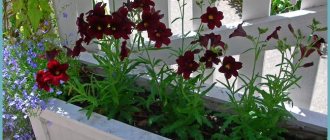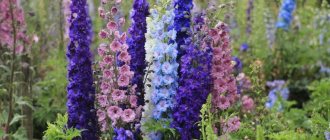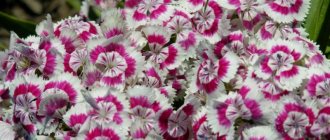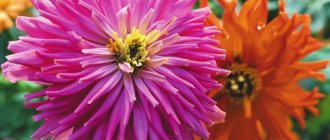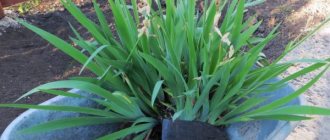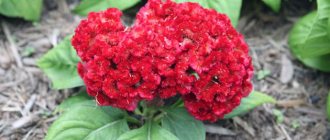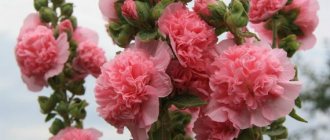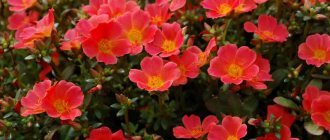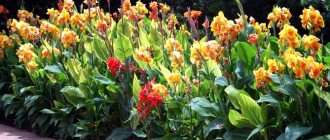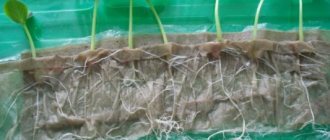Eschscholzia belongs to the Poppy family, which includes several dozen different species. This plant was first found in North America, in its western part.
Its color resembles gold, which is why the Spaniards jokingly call Eschscholzia the golden cup. The plant is very beautiful and romantic, but does not require special care and is becoming increasingly popular in cultural cultivation.
Description and features
It is a herbaceous perennial shrub with a tap-shaped root. The shoots are thin and numerous. The flowers resemble poppies, colors range from yellow to red and their shades, single or double, depending on the variety.
Blooms from summer until winter. However, one bud lives only a few days; it is replaced by a larger number, approximately 1/2. The hallmark of this plant is not only the delicate flowers, but also the white, bluish coating on the stems and leaves.
Description of the plant
Eschscholzia is a herbaceous perennial that has a taproot system. The plant can reach a height of forty centimeters. Despite the fact that eschscholzia is considered a perennial, it is grown in culture as an annual plant.
California poppy has many thin shoots. The leaves are located on long petioles, have a bluish-green color, and are dissected. The flowers are cup-shaped, solitary, and can reach eight centimeters in diameter. The flowers strongly resemble poppies and can be double or simple. The color palette is varied: red, orange, yellow, white and many shades of these colors. These flowers have a certain peculiarity - in windy and cold weather they do not open, even if it is warm outside, but the sky is overcast, the eschscholzia will not open its flowers. The plant also has a fruit - this is a seed capsule, the diameter of which ranges from three to nine centimeters.
Type and varieties of Eschscholzia
In nature and in gardens, both single species and inflorescences are found.
Californian
The most common. In addition, all the varieties under consideration are varieties of Californian.
The plant is perennial, spreading along the ground. It has fairly strong stems, of medium height, about 50 cm in height. The buds are single, 8 cm in diameter.
| Variety | Description |
| Strawberry | Flowers with a semi-double structure are also common. Presented in a gradient of 2 colors, red and yellow. Does well in rocky soil. |
| Peach sherbet | This variety has flowers that are only semi-double and have a creamy, beige color. The number of petals is large, reaching 12 pieces. The height of the stem is slightly less, 25 cm. |
| Carminking | Height is about 30 cm, flowers are up to 8 cm in diameter. The petals have ruby color. |
| apple blossom | Bright pink double flowers. A distinctive feature is dense foliage, a large number of stems and buds. |
| Chiffon | As you know, hybrids take the best from their ancestors. The advantages of this variety are its record flowering. It begins in early May and ends when frost sets in. The buds have a terry structure and their color is unique. Blooms in groups, with each flower having its own shade. |
| Ballerina mix | Hybrid. It has regular and double buds in its arsenal. Their shades range from light pink to orange. The flowers themselves are quite large, about 9 cm in diameter. Stems are medium, 40 cm. |
| Mikado | The shoots are medium, up to 40 cm in height. The buds are large, about 7 cm in diameter. Has straight petals. The color is a gradient of orange and bright yellow. |
Features of Eschsolzia
Eschscholzia is a herbaceous bushy perennial plant, the height of which can reach up to 0.4 m. It is cultivated as an annual flower. Tap root. There are a large number of thin stems. The openwork leaf plates are deeply dissected, they are colored green-gray and have long petioles. Single cup-shaped flowers reach 8 centimeters in diameter. The flowers can be double or simple, but in appearance they are similar to poppies. Their color can be yellow, red, white, orange, and they can also be painted in various shades of these colors. Such flowers have one peculiarity; the fact is that on a cloudy, rainy, windy or cold day, as well as at night, they close. The fruit is a capsule, the size of which varies from 3 to 9 centimeters.
Esholtsia - sunny poppy. Peculiarities . Growing.
Growing Eschscholzia from seeds
The simplest and most effective method of propagation is seed. Seeds can be stored for a long time, while they retain their properties.
Sowing dates, pros and cons
An excellent solution would be to plant the seeds in the fall. This allows them to be stratified 100%. Moreover, the weaker ones simply do not survive in such conditions, and the flowering of eschscholzia will be early. To do this, you need to prepare special grooves, about 5 cm deep.
Seeds are sown by lightly pressing them into the soil. Mulch from loose humus is poured on top of them; its layer is no more than 2 cm thick. This is done to prevent the soil from freezing where the plant is planted, as this greatly impedes the development of the root system.
Autumn sowing usually occurs in October. Mainly in dry weather, only with the onset of frost.
Some people, on the contrary, prefer to plant seeds in the spring. However, to do this, they need to undergo certain training before disembarking. They are placed in a special cotton bag, and it is already in the refrigerator on the bottom shelf. They need to be stored there for at least a month before planting.
Collecting seeds
If the self-sowing option does not suit you, then you need to collect California poppy seeds yourself. This is not difficult to do. However, some are wondering how to collect eschscholzia seeds. It is necessary to put gauze bags on large wilted flowers. This is necessary so that the seeds do not fall out of the box into the ground. They can be removed immediately after ripening. And full ripening occurs exactly a month after the flower withers. After collecting the seeds, they must be laid out on paper and dried. Seeds are stored in paper bags. After wrapping the planting material, you should store it on the bottom shelf of the refrigerator. If all collection and storage rules were followed correctly, the planting material will retain its viability for three years.
Technology for sowing Eschscholzia at home
The plant does not tolerate transplantation at all, but this does not stop flower growers. Around the beginning of March, you can start growing eschscholzia on the windowsill in your apartment, but not using the usual method. Only peat tablets are used. This is done in order not to damage the root system of the plant during transplantation.
The tablet is placed in water to soften it. Then 2-3 seeds are placed into it using a toothpick. After which they are sprinkled with peat, and the surface is moistened.
It is recommended to cover the seedlings with plastic film; the greenhouse effect will allow for faster seed germination. When the first shoots appear, the film must be removed and the seedlings themselves must be placed in a cooler, bright place.
15 days after germination, you need to feed the plants with a special mineral mixture.
If it is necessary to transport the plant to open ground, this is done together with the tablet; it decomposes in the soil, and the root system is not damaged in any way during transplantation.
About 3 weeks before planting seedlings in open soil, hardening of the seedlings begins.
This is done by placing the container with the sprouts in the open air for several hours. Hardening is necessary so that when transplanted into open ground, the plant does not die from sub-zero soil temperatures.
Growing
Growing perennial eschscholzia in open ground will not cause you much trouble. It is only necessary to regularly loosen the soil and apply fertilizers in a timely manner. If the summer is rainy, then there is no need to water the plant. This is only necessary during dry periods.
As already mentioned, the flowering of eschscholzia is quite long, and this can be facilitated by mineral fertilizers, which must be added to the soil before flowering begins. These fertilizers should include potassium, nitrogen, phosphorus, and ash infusion in a ratio of 1:10. To fertilize California poppy, you should not use organic fertilizers, as this can lead not only to disease, but also to the death of the plant.
Please note that perennial Eschscholzia actively reproduces by self-sowing, however, some gardeners do not like this. If you are one of them, then after the flowers fade, you must immediately remove them along with the seed pod. When the plant has completely faded, you can remove the old shoots; new ones will appear in their place quite quickly, moreover, in a few weeks they will begin to bloom.
Planting Eschscholzia in open ground
Sandy soil is recommended for planting; it must be well drained.
Landing dates
Seedlings should be transplanted into the soil when the threat of frost has passed. Usually this is May-April.
However, it all depends on the landing region.
Landing Features
Initially, it is necessary to prepare small planting holes. Keep a distance between them of at least 30 cm, this is due to the strong spreading nature of the bushes. The seedling is immersed in a pre-dug hole along with a peat tablet, after which it is sprinkled with soil, then compacted. After this, water it. Flowering is observed after about a month.
Features of cultivation
Eschscholzia, which is grown from seeds, is stored in seeds for no more than three years. After this, germination will be lost.
Planting occurs immediately in the ground, since the plants are rod-shaped and long, which means that replanting will be disastrous. It is allowed to plant the plant under glass.
Shoots will appear in a couple of weeks. After 4 leaves are formed, the eschscholzia can be thinned out. Mature plants can reach a height of 60 cm. Over time, the bush will occupy the entire flowerbed.
Overripe fruits, after cracking, shed seeds, eventually self-seeding. This is wonderful, as it allows the plant to renew itself repeatedly in one place for many years. It is for this reason that novice gardeners use Eschscholzia to create simple flower beds.
At the beginning of summer, bean aphids can noticeably damage the leaves of Eschscholzia. The drug “Commander” will help fight it. To do this, spray the affected flowers.
If the weather is dry, spider mites may appear. If you have such a problem, you will have to remove the affected bushes.
It happens that diseases such as yellowing and shrinking of bushes occur. Such plants will have to be removed so that the infection does not spread to healthy bushes.
Caring for Eschscholzia in open ground
This plant is unpretentious by nature, requiring only fertilizing and timely watering. The latter must be carried out exclusively in the evening, before sunset. In this case, the flow of water must be directed precisely under the root of the plant so as not to affect the inflorescences or damage them.
Mineral fertilizer with a predominance of phosphorus, nitrogen and potassium is excellent for feeding. It promotes overall plant growth and an increase in the number of inflorescences.
Organics are highly not recommended; because of it, the Eschscholzia will die.
To allow air to reach the roots, the soil must be loosened regularly, and dried buds must be destroyed in a timely manner.
Eschscholzia - simple growing rules
If you want to have a flower on your property that will reproduce on its own and will not require special care, pay attention to Eschscholzia. It is also called California poppy, as well as wormwood (the leaves are similar to wormwood leaves). This plant will decorate flower beds and borders, and will look great in mixborders and solo, in flowerpots or on the balcony. Eschschólzia is an unpretentious plant, but in order to achieve its lush flowering, (especially at first) you need to adhere to some growing rules.
Eschscholzia - simple growing rules.
Eschscholzia after flowering
At the end of flowering, the seeds are collected and the plant is prepared for wintering.
Collecting seeds
In general, Eschscholzia reproduces well by self-seeding, so collecting seeds is not necessary. If in the future it is planned to plant the plant in the same place, you can “let the process take its course.” Next spring, several dozen beautiful flowers will delight the eye. However, if they are supposed to be planted in another place, it is necessary to put special gauze bags on the flowers. Then, after 4 weeks, cut off the seed pods and only then remove the seeds.
Gauze bags allow you to isolate seeds from the outside world, thereby preventing the emergence and development of various diseases. I dry it and then put it in the refrigerator for storage.
Preparing for winter
In the fall, the remains of plants are cut off and the area is thoroughly dug up. In the spring, strong stems will definitely appear there; they will be thinned out and fed. In just a month they will already bloom.
When and how does it bloom
A characteristic feature of the plant is that the flowers curl into cone-shaped buds in rainy and cloudy weather, at dusk. The life of each flower is short-lived: only 3-4 days. The plant has a great potential for bud formation; new ones are constantly opening to replace faded flowers.
Types of flowers
The most common is Eschscholzia with simple flowers with 4-5 petals. There are also modern varieties with semi-double and double, corrugated petals.
Flower shapes
Single flowers are cup- or goblet-shaped. The pistil and stamens are orange-yellow and shorter than the petals. There are double varieties with flattened flowers, similar to blooming roses or camellias.
Flowering period
California poppy is a plant that blooms throughout the growing season. Most varieties open their first buds in late May-early June and continue continuous flowering until the onset of cold weather.
Changes in care during the flowering period
To form a large number of buds, you should not allow Eschscholzia to set seed pods that look like a pod. Timely removal of ovaries will promote lush flowering for a long time.
Diseases and pests
Eschscholzia is highly resistant to various kinds of diseases, but does not have immunity from all diseases. The most common problem with this plant is root rot. It is caused by excess moisture in the soil. This disease manifests itself by the wilting of the flower. The only way to know for sure is to dig up the root. If there is a gray coating on it, then it is gray rot. The affected plant is removed, its neighbors are treated with a fungicidal solution, and watering is temporarily stopped.
During dry periods, the main problem is spider mites. It manifests itself by enveloping the leaves in cobwebs, and on the leaves themselves you can observe small, running dots. Acaricides are ideal for treatment.
Aphids are also a common problem with Eschscholzia. However, it is easy to cope with it; it is necessary to spray the affected plant with cold water, and pollinate it and neighboring plants with a fungicidal solution.
Pests and diseases of eschsolzia
Of the harmful insects, spider mites and bean aphids “love” eschscholzia. They usually appear during dry summers with insufficient rainfall. To combat them, insecticidal preparations are used, for example, “Commander”.
Excessive watering can cause the development of various rots in the plant. As a rule, the roots and/or root collar rot first. In the early stages, the flower can be saved by sharply reducing watering, loosening the soil, removing rotting areas (as far as possible without digging up the bush).
Eschscholzia pod with seeds.
Eschscholzia pods.
With dense plantings and excessive watering, powdery mildew “attacks” the clearing. If the damage is minor, the bush can be saved by treating it with sulfur-containing preparations.
Mister summer resident recommends: medicinal properties of eschsolzia
In fact, every plant in nature has a special purpose. The same is true with this flower. The ancient Indians long ago studied the issue of the medicinal properties of eschscholzia. With its help, they relieved toothache and fought lice. Even pollen was used; it was used to improve skin elasticity and restore its former attractiveness. Modern medicine uses the extract of this plant as one part of multicomponent medications. It is included in sedatives and pain relievers. In addition, medicines based on eschsolzia are 100% safe, which allows them to be used by all people, regardless of age or individual problems with the body.
However, it is worth keeping in mind that nothing is perfect, and eschscholzia-based drugs also have side effects that can only develop if the dosage is exceeded. These include the development of allergies. It does not matter in what form the medicine was used. There may be a decrease in effectiveness, which often leads to an increase in dosage. To avoid unpleasant consequences, you must strictly follow the doctor's instructions.
Features of garden care
California poppy is an unpretentious and hardy plant. Any novice gardener can handle planting and caring for Eschscholzia.
What conditions do the Eschscholians like?
The flower prefers to grow in well-lit places with light, loose sandy and sandy loam soils. The optimal soil acidity for Eschscholzia is 6.2-7.
What is the plant afraid of?
The bushes do not develop well when planted in lowlands, on heavy clay soils, where water stagnates in the spring and in rainy weather.
On a note! Planting a flower in partial shade significantly reduces the intensity of flowering.
Watering
The taproot system of Eschscholzia is capable of receiving moisture from deep layers of soil. For most of the year, the plant needs enough water from precipitation. The flower is watered during periods of prolonged drought, trying to direct the stream under the root without wetting the leaves. Overmoistening is more detrimental to Eschscholzia than lack of moisture.
Mulching
Adding mulch has a beneficial effect on the development of the plant. The soil around the flower can be loosened and weeded less frequently. Mulching serves as an additional source of nutrients.
Loosening
Weed removal and loosening should be done very carefully. Eschscholzia has a fragile root system that is easily disturbed. Careless handling can lead to the death of the flower.
The plant does not require care
Feeding
When planted in fertile soil, Eschscholzia will bloom all season long, even without fertilizing. You can support the plant by applying fertilizer twice during the growing season:
- fertilizing with complex mineral fertilizer - during budding;
- watering with water and fertilizer a month after the start of flowering in half the concentration.
Fertilizers are applied in diluted form. Before applying fertilizer, the plant is watered.
Transfer
Many people are interested in the question: is it possible to replant eschscholzia bushes. The flower is extremely difficult to tolerate transplantation. In most cases, the plant dies. Surviving bushes take a long time to take root in a new place.
Advice! Growing a flower through seedlings is a good way to plant Eschscholzia in the right place.
Reproduction of Eschscholzia
In nature, the plant reproduces by self-seeding. In garden plots, the best way out is propagation using seeds. In autumn, the plant will bloom faster, since this option is closest to natural. For planting, it is best to use sunny places where water does not accumulate. For sowing in spring, it is recommended to keep the seeds in the refrigerator.
Seedlings, unlike most plants, are not grown. It's all about the characteristics of the root system.
It is complex, goes deep into the ground, which means replanting it will be difficult and unjustified. In the case of autumn planting, you can cover with foliage.
So, eschscholzia is an amazing annual plant that is very easy to care for. Moreover, its propagation occurs by self-sowing, which means that amazing butterfly-like flowers will bloom in your garden plot year after year.
Seedling
Despite the fact that the method of planting seeds in open ground is very simple and popular, experienced gardeners prefer to grow seedlings. Further in the article we will consider the process of growing eschsolzia from seeds at home into seedlings.
At the beginning of the article it was mentioned that the plant has a long tap-shaped root, which can be severely damaged during transplantation. To avoid this, you should plant the seeds for seedlings in peat tablets. But first, it’s worth learning more about growing eschscholzia from seeds (when to plant and how) to obtain seedlings.
How to sow Eschscholzia for seedlings correctly
Planting Eschscholzia seeds for seedlings is carried out according to a very simple scheme:
- It is recommended to place a drainage layer of about 1-1.5 cm at the bottom of each cup (except for products made from peat); perlite is ideal for these purposes.
- Fill the containers with soil, leaving a short distance to the edges.
- It is recommended to sow 2-3 seeds in one glass, in case some of them turn out to be non-viable and cannot germinate. If all the seeds germinate, then it will be possible to remove the weakest seedlings and leave one of the strongest and strongest.
- Transfer a few seeds to the surface of the soil. Since they are quite small, it is convenient to carry them with tweezers or a toothpick (wet the tip of the product, pick up the seed, and brush it onto the ground with another dry toothpick). You need to maintain a distance of about 2-3 cm between the seeds.
- Cover the seeds with a thin layer of soil on top (literally 1-2 millimeters).
- Water generously from a spray bottle using warm, settled, clean water.
- Cover each cup with a lid or film to create a greenhouse.
Note! If you want to plant eschscholzia seeds in peat tablets, then you need to follow a slightly different technology. First, soak the tablets in a tray in warm water for 20-30 minutes until they swell, drain off any remaining moisture, slightly loosen the surface of the tablet and place 2-3 seeds in the center, and then cover with a 1-2 mm layer of peat. Cover with a lid and film.
Growing flowers by seedling method
If you decide to grow Eschscholzia from seeds at home, place the seed material in the lower section of the refrigerator. This way you will both save the seeds and stratify them.
Do not forget that when growing Eschscholzia flowers for seedlings, the picking process is eliminated. This is due to the peculiarity of the root system of the Californian poppy. The slightest damage to the roots and the plant will inevitably die.
Therefore, experienced gardeners when growing Eschscholzia, when it’s time to plant seeds, prefer to use peat tablets, plastic disposable or collapsible cups for growing seedlings, as in the photo.
The main thing is to keep the root system intact when replanting.
Growing seedlings
Planting Eschsholzia seedlings does not present any particular difficulties. When sowing flowers in peat tablets, you need to properly prepare the containers:
- Place the tablets in a plastic container.
- Pour water into the pan and wait until the tablets absorb the water. Add water if necessary.
- Peat tablets will be ready for use when they stop absorbing moisture. Drain excess water from the tray and begin planting.
- Eschscholzia seeds are very small. It is very convenient to place them in planting containers using a wet toothpick. Place 2 seeds in each tablet and sprinkle them with a small layer of soil.
- Irrigate the plantings with a spray bottle and place them in a warm, bright place. It is undesirable for the seedlings to be exposed to direct sunlight.
When sowing Eschscholzia seedlings in plastic or collapsible cups, the planting method is no different from planting other flowers.
Seedlings need to be watered as the soil dries. Under no circumstances should you flood the plantings. Monitor the microclimate of the room. Optimum air temperature +21˚С +23˚С, humidity – no more than 40%-55%.
The first green shoots will delight you in 1.5-2 weeks. If you wish, you can feed Eschscholzia flower seedlings with complex mineral fertilizers 15-20 days after seed germination.
At least 2-3 weeks before the intended transplantation of Eschsholzia into open ground, the seedlings need to be hardened off. Accustomed to home conditions, Eschscholzia grown from seeds is not resistant to frost and sudden changes in ambient temperature.
Hardening should begin with an open window, near which you should place boxes or trays with seedlings. Subsequently, the plantings must be taken out onto the veranda or balcony. At first, the “walk” time is 30-40 minutes. Gradually increase the duration to 3-4 hours. After hardening, the seedlings will be able to withstand a temperature drop to –5˚C.
Transplantation into open ground
You can transplant Eschscholzia into open ground when the air temperature warms up to +18˚С +22˚С. The optimal planting time in the southern regions of Russia occurs in the second half of April. But in regions with a more severe climate, you should not start replanting before the second half of May.
The flower garden needs to be prepared in advance. Add sand and humus and dig the soil thoroughly. Prepare small holes 15-20 cm deep. The distance between planting holes should be at least 30-35 cm, since Eschscholzia bushes grow quickly.
Carefully, being careful not to disturb the earthen ball, place the seedlings in the planting hole. Fill the voids with soil. Compact the soil at the base of the flower and water the future flower garden.
It is advisable to water Eschscholzia from a watering can, early in the morning or late in the evening. Make sure that moisture does not accumulate in large quantities on the flower beds.
The first buds on young bushes will appear 30-40 days after sowing.
Aftercare
After planting in open ground, Eschscholzia flowers do not require special care. Every gardener has long known such activities as weeding and loosening.
There is no need to water flower beds with Eschscholzia too often. Thanks to its long roots, the plant can absorb moisture from the deep layers of the soil. Therefore, flowers only need watering during dry periods. In normal weather, California poppy gets enough moisture from rain and dew.
To stimulate abundant and long-lasting flowering, you can fertilize Eschscholzia with mineral fertilizer, which contains potassium, nitrogen and phosphorus. The feeding scheme looks like this:
- 1st time - during transplantation into open ground;
- 2nd time - after 3-4 weeks.
As soon as the first buds appear on the bushes, fertilizers should be abandoned.
If you don’t have mineral fertilizers, you can fertilize the soil with ash when replanting Eschsholzia flowers. Just add a handful of ash to each hole.
Having grown Eschscholzia once, you can admire its bright, unique buds every year. Flowers reproduce well on their own by scattering seeds. If you do not plan or for some reason do not want Eschscholzia to grow randomly, remove wilted buds every week.
When the California poppy bushes have completely faded, remove old shoots from the flowerbed - Wormwood grows very quickly. In place of the old plant, young shoots will soon appear, which will bloom magnificently in a few weeks.
Important! You cannot fertilize flowers with fresh organic matter.
Diseases and pests
Despite the ease of care and high resistance to many diseases and pests, when growing Eschscholzia flowers from seeds, it is important to strictly adhere to the recommendations of gardeners.
Like all plants, Eschscholzia may be attacked by bean aphids in June. The drug “Commander” will help you cope with these insects.


